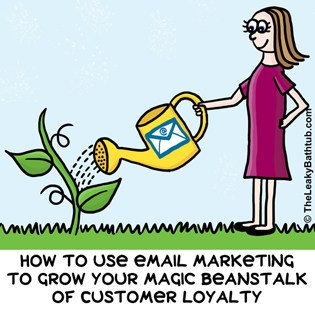
In the last article you saw why email marketing is so important in customer retention… but what is “email marketing”?
There’s often some confusion around this, so I’ve identified three specific kinds of emails that make up “email marketing”.
But before we get into the technical details, here’s a more human way to approach the different types of email marketing. Let’s look at email marketing in terms of personality types.
The three different email marketing personality types
Imagine that you had three co-workers:
- Simon always wanted to sell you stuff: health supplements, holiday time shares, imitation designer accessories… just about anything! It gets really annoying, and you try to avoid bumping into him after a while.
- Nigel is really smart and knows all the latest news and info… but he’s just soooo serious, you can’t have a laugh with him. You’re happy to hang out at work, but he isn’t someone you’d necessarily want to have a beer with too often.
- Rebecca is like a walking reminder system. She always knows which meeting room to go to; what time; when the work’s due… it’s helpful, but again, she’s not really someone you want to spend time with outside of work.
Do you see how these three people are a bit, um, annoying in isolation?
Yet this is how many businesses approach their email marketing
Many businesses will just use one of these approaches (or personalities) in their email marketing: it’s all newsletters. Or it’s all sales offers. Or it’s all follow-up reminders.
Look at the newsletters you get in your own In Box: I’m right, yes?
But being a one-dimensional email marketer will affect your sales
Continually using the one, same tactic for your email marketing holds you back from achieving maximum sales. And that’s because you’re always talking to your prospect or customers in the same way.
Imagine if you mixed things up a little…
So imagine that you had a new co-worker: perfect Peter!
Peter’s a smart guy and he knows lots of news and topical information, just like Nigel. But he’s also a guy who likes to go out and have fun. He knows when the fishing gear or golf clubs you want are on sale… but he’s not pushy about it, like Simon is.
And yes, Peter is even a little bit like Rebecca, in that he’ll remind you if a sale is finishing soon, to make sure you don’t miss out on the stuff you like.
Peter really is the perfect, all-round buddy – at work, and outside of work.
Your goal is to make your email marketing well-balanced, like Peter
Imagine how much more engaging your email marketing would be if it communicated with your clients in these different ways. Your business would be seen as being interesting, helpful, relevant, on-the-button, personable and trustworthy.
And the benefit for you? Well, you’d be making more sales if you had such a well-balanced email marketing programme!
After all, if you command this level of respect from your readers, they’ll be more likely to open your emails. And they’ll also be more likely to click on your sales links.
Best of all, creating a well-balanced email marketing programme is relatively easy, and can greatly maximise the return on your investment.
How do you create a well-balanced email marketing programme?
For your email marketing programme to be well-balanced, you need to use all three types of email marketing available to you.
Let’s take a look at the three types of email marketing tactics at your disposal, and their pros and cons:
1. Sales offers
Announcing promotions and special offers are an important way to make sales… but if this is all that you’re sending your subscribers, they’ll soon tire of the constant bombardment of sales messages.
Non-stop sales messages are boring. They don’t add any value to your relationship with the reader. They get old very quickly.
Therefore, if all you’re doing is sending out sales offers, in time your email open rate will plummet, and your unsubscribe rate will soar. Not good!
2. Newsletters
On the other hand of the email marketing spectrum you have newsletters. Email newsletters inform and educate the reader, and add value to your relationship with them.
Newsletters are great for keeping at front-of-mind with your clients and generating repeat business and referrals – though that can be hard to measure.
The reason why newsletters are hard to measure is because the sales message is subtle, so it’s not a case of hitting “send” and your phone starts ringing like crazy. Instead, newsletters build long-term value and relationships in your business.
In fact, I’ve seen some newsletters that are so subtle I didn’t even know for sure what the sender is selling! (So don’t make that mistake either!)
With newsletters, I’d suggest keeping the content 80% value-added and 20% sales messages. The focus needs to be firmly on the value-added component, or it’s not a true newsletter. Do include a bit of a sales message, but keep it subtle, and near the end of your email.
In short: newsletters are very important, but they need some back-up to get the sales cranking.
3. Autoresponders
Autoresponders are a series of automated follow-up emails that are sent out at pre-determined intervals. They’re a common tactic in internet marketing, where you sign up to get a free eBook or something, and then you get autoresponder messages every few days thereafter.
Autoresponders in isolation can work phenomenally well. They’re a very soft follow-up message, which builds bridges with your reader, rather than being too pushy.
However, essentially autoresponders are still sales follow-ups, and if you’re not adding more substance to your communications (e.g. with newsletters), readers will tire of them. In the internet marketing world that may be considered an OK tactic, but if you’re in service business, or sell physical products, you’d be well advised to have a longer-term outlook. That is, to focus on building a long-term value-added relationship with your customers and prospects.
What if your email campaigns don’t fit any of these 3 definitions?
If your email content doesn’t fit these three descriptions, and they’re some kind of hybrid, that’s a problem.
And the reason that it’s a problem is that it can be confusing to readers. Moreover; they’re confusing for you as the email doesn’t have a clearly-defined purpose.
For example, I’ve seen so-called “newsletters” transform into sales emails when the business owner goes through a quiet patch. They’re desperate for sales, so the emails become all about the sales, and less about adding value.
These hybrid emails may work in the short-term, but in the long-term the open rates start dropping, and the unsubscribes increase. Not at the same rate as for purely sales-based emails, but it still happens… and that’s totally avoidable. I’d recommend that you pigeonhole the content into the three categories I’ve outlined.
So, for example, if you go through a quiet patch, keep your newsletters strictly as newsletters. Keep focused on adding value. But you can send additional emails with sales offers (and then follow-up on those sales offers with some soft autoresponder-style follow-ups). That’ll maintain your integrity as a value-added supplier, whilst still generating sales from your email list.
Let’s look at how these three email types fit together in a little more detail…
How do you use all 3 types of email marketing together?
The exact mechanics of your email marketing campaign will depend on your business, your industry, your resources, and how often you have promotions.
For example, some companies send newsletters weekly; others monthly, or quarterly or whatever suits. So the exact mechanics and timings will differ. But here’s how I’d approach things:
(a) Plan your newsletters first and foremost
Your newsletters are the most important element of your email marketing campaign, so prioritise these first and foremost. The other types of email marketing can then fit around your newsletters.
As to how often you send newsletters, go with what’s achievable. (Quarterly is an absolute minimum… otherwise people won’t remember who you are, and you may as well not bother!)
So get the newsletters into your schedule, and stick to that schedule.
(b) Plan your sales emails around your newsletters
When you’re consistently adding value via your email newsletters, it’s perfectly OK to send sales emails to your subscribers. (In fact, you should send sales emails! After all, you’re in business to make sales!)
Again, how often you send these emails will depend on your business, and what you’re promoting.
Example: Imagine that you send monthly newsletters already, and now you have a major new product to promote. Send the sales email 1 to 2 weeks after the monthly newsletter, to stagger the messages.
(c) And now for the automatic reminders…
Studies have shown that it takes numerous follow-ups to make a sale. That’s where your autoresponders come in.
Even with the best will in the world, clients who are genuinely interested in your offer will forget to buy it, because they have so many other demands on their time. (I’m sure you’ve forgotten to buy a business widget, because something else came up that was urgent.)
A trickle of autoresponders will gently nudge people back to your sales message. You don’t want to repeat the sales message – that’ll make you look like Simon in the story earlier on.
No, you want to gently nudge your client to buy. And a well-written autoresponder will do that – and without being pushy or offensive. Just drip-feed these emails every 3 days or so for 3 weeks (during which time your reader will receive another value-added newsletter).
Won’t people mind the follow ups? Will they unsubscribe?
Yes, there is a good chance that some people will unsubscribe. But rather than getting too worried about it, you should thank these people for keeping your email list clean.
If you’ve got good email content, you really shouldn’t worry about the people who unsubscribe. They’ve either identified themselves as not being in your target market, or they’re cheapskates who will never ever buy anything from you anyway.
So don’t worry about the cheapskates: you’re not here for them, you’re here for those clients who will (and do) buy from you.
Now your email marketing will be Peter-perfect!
With newsletters, sales messages and autoresponders all working together in perfect unison, your email marketing will be humming!
Sure, you will need to test and measure and make some tweaks and tucks, but a well-rounded email marketing programme will be a good friend to you – and to your clients.
Remember: people like to buy, if the process is enjoyable and what you offer adds value to their lives. And with the approach I’ve outlined in this article, that’s exactly what you’ll be doing. You’ll be as helpful a person to them as your buddy Peter is to you. Awww! 😉
Summary:
The ideal email marketing programme is made up of all 3 types of email marketing:
- Newsletters: A long-term tactic that adds-value and builds trust and credibility, and thus your relationship with the reader. Put the newsletters into your marketing programme ahead of any other kind of email marketing.
- Sales offers: A short-term tactic to generate revenue, but it’s best used sparingly or it’ll annoy your readers. Fit your sales offers around your newsletter schedule.
- Autoresponders: A short-term tactic that’s essentially a soft follow-up to your sales offers. They’re written in a personal way that build trust with the reader, so they’re not as brazen or as annoying as sales offers. Fit your autoresponders around your sales offers.
This balanced approach to email marketing will help to grow your sales in both the short-term and the long-term.



